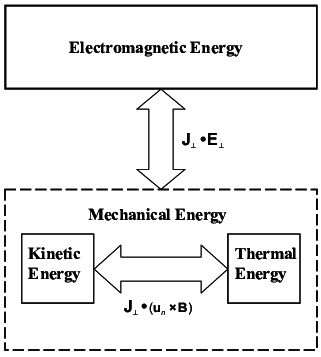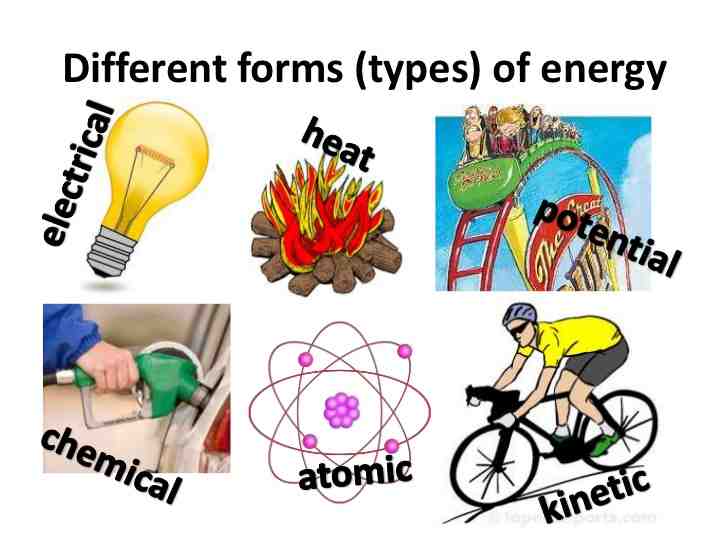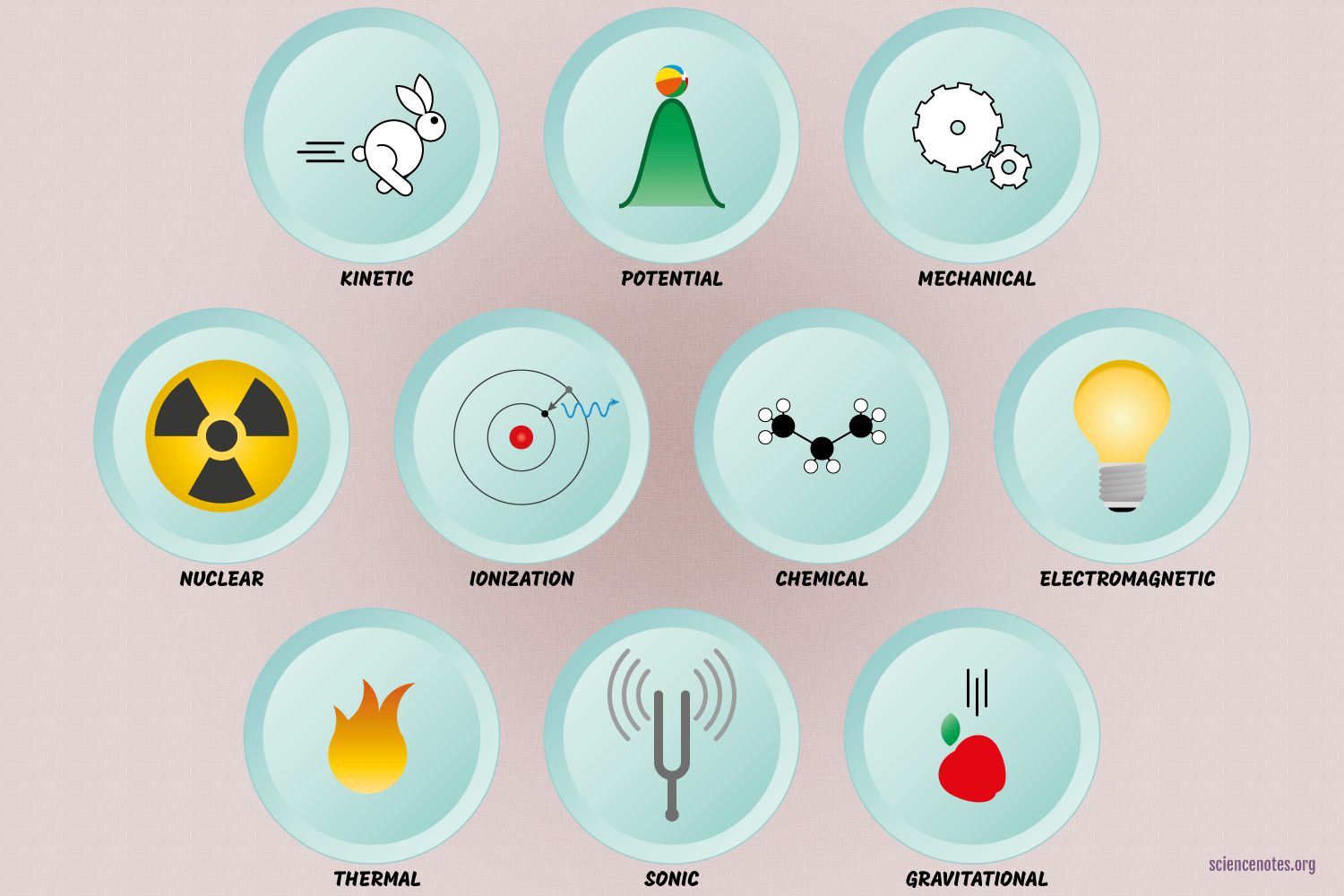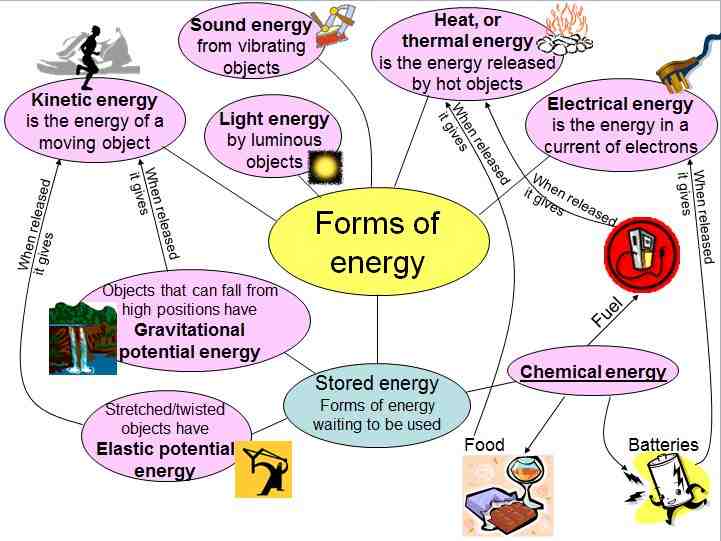What are the 5 forms of energy melts?
Contents
Use this MELTS (mechanical, electrical, light, heat, and sound) forms of energy poster as an anchor diagram as students learn about the various forms of energy.
What abbreviation is used to remember the different forms of energy? * Mnemonic device: HCSME! * Light, sound and nuclear energy (like the atomic bomb) are also forms of energy, but more emphasis is placed on the 5 main forms.
What are the 5 types of energy?
What are the five types of energy?
- Electrical power.
- Chemical energy.
- Mechanical energy.
- Thermal energy.
- Nuclear energy.
What are the 6 energy types?
There are six basic forms of energy: chemical, electrical, radiant, mechanical, thermal and nuclear. In other research, you may find additional forms mentioned such as electrochemical, sonic, electromagnetic, and others. However, many other forms are combinations of these six basic categories.
What are 5 energy changes?
Battery (electricity) (chemical energy – electrical energy) fire (chemical energy – heat and light) electric lamp (electrical energy – heat and light) microphone (sound – electrical energy)
Is wind a energy?

Wind is actually a form of solar energy. Winds are caused by the warming of the atmosphere by the sun, the rotation of the earth, and the irregularities of the earth’s surface. As long as the sun is shining and the wind is blowing, the energy generated can be used to send electricity via the grid.
Is wind a force or an energy? The power of the wind A wind turbine converts wind energy into electricity by using the aerodynamic power of the rotor blades, which function like an airplane wing or a helicopter rotor blade. When wind blows over the leaf, the air pressure on one side of the leaf decreases.
What is wind energy classified as?
Wind power, a form of energy conversion in which turbines convert the kinetic energy of the wind into mechanical or electrical energy that can be used to generate energy. Wind power is considered a renewable energy source.
What is a major disadvantage of wind power?
The two main disadvantages of wind power include the cost of acquisition and the immaturity of the technology. … Offshore wind energy produces more energy than onshore wind energy, but it costs much more to build. The primary costs of wind turbines include construction and maintenance.
What are some of the negatives with a wind turbine?
Wind turbines, on the other hand, can be noisy and aesthetically unattractive, and sometimes interfere with the physical environment around them. Similar to solar energy, wind power is also intermittent, meaning that turbines are weather-dependent and therefore cannot generate electricity around the clock.
Is wind blowing energy?
Wind is energy in motion – kinetic energy – and a renewable energy source.
What are 2/3 disadvantages of wind energy?
Disadvantages of wind energy (disadvantages)
- Cost considerations.
- Unpredictable source of energy.
- Noise pollution.
- Biological and environmental impact.
- Appearance.
What are some negative effects of wind energy?
Like all energy supply options, wind energy can have negative effects on the environment, including the potential to reduce, fragment, or degrade wildlife, fish and plants. In addition, rotating turbine blades can pose a threat to flying wildlife such as birds and bats.
Is wind energy energy?
Wind is an emission-free energy source Wind is a renewable energy source. Overall, the use of wind to generate energy has less of an impact on the environment than many other energy sources.
Is wind a good source of energy?
Wind is a very sustainable source of energy. … Wind power is sustainable because it is an energy source that neither generates waste nor causes CO2 emissions, soot, smog, acid rain or global warming. In addition to solar energy and waste to fuels, wind power is one of the cleanest and most sustainable energy sources that we can use.
What energy is wind an example of?
Wind is an example of kinetic energy.
How many types of energy are there?

There are six basic forms of energy: chemical, electrical, radiant, mechanical, thermal and nuclear.
What are the 7 types of energy? Energy exists in many different forms. Examples are: light energy, thermal energy, mechanical energy, gravitational energy, electrical energy, acoustic energy, chemical energy, nuclear or atomic energy and so on.
What are the 13 forms of energy?
The different types of energy include thermal energy, radiant energy, chemical energy, nuclear energy, electrical energy, kinetic energy, sound energy, elastic energy and gravitational energy.
What are the 10 energy types?
There are posters for all types of energy: mechanical, kinetic, potential, gravitational, thermal, chemical, electrical, light, radiation, sound and nuclear energy.
What are the forms of energy?
Energy exists in many different forms. Examples are: light energy, thermal energy, mechanical energy, gravitational energy, electrical energy, acoustic energy, chemical energy, nuclear or atomic energy and so on. Each form can be converted or modified into the other forms.
What are the 5 types of energy?
What are the five types of energy?
- Electrical power.
- Chemical energy.
- Mechanical energy.
- Thermal energy.
- Nuclear energy.
What are 5 energy changes?
Battery (electricity) (chemical energy – electrical energy) fire (chemical energy – heat and light) electric lamp (electrical energy – heat and light) microphone (sound – electrical energy)
What are the 6 energy types?
There are six basic forms of energy: chemical, electrical, radiant, mechanical, thermal and nuclear. In other research, you may find additional forms mentioned such as electrochemical, sonic, electromagnetic, and others. However, many other forms are combinations of these six basic categories.
What are the 10 energy types?
There are posters for all types of energy: mechanical, kinetic, potential, gravitational, thermal, chemical, electrical, light, radiation, sound and nuclear energy.
How many energy are there?
There are six basic forms of energy: chemical, electrical, radiant, mechanical, thermal and nuclear. In other research, you may find additional forms mentioned such as electrochemical, sonic, electromagnetic, and others. However, many other forms are combinations of these six basic categories.
What are all the 10 forms of energy?
Examples are: light energy, thermal energy, mechanical energy, gravitational energy, electrical energy, acoustic energy, chemical energy, nuclear or atomic energy and so on. Each form can be converted or modified into the other forms.
What are the 10 energy types?

There are posters for all types of energy: mechanical, kinetic, potential, gravitational, thermal, chemical, electrical, light, radiation, sound and nuclear energy.
Which 10 forms of energy are there? Examples are: light energy, thermal energy, mechanical energy, gravitational energy, electrical energy, acoustic energy, chemical energy, nuclear or atomic energy and so on. Each form can be converted or modified into the other forms.
What are the 13 forms of energy?
Items in This Set (13)
- Energy. The ability to make a change.
- Kinetic energy. The energy an object has because it is in motion.
- Electrical power. The energy that an electric current carries.
- Potential energy. …
- Gravitational Potentials Energy (GPE) …
- Chemical energy. …
- Nuclear energy. …
- Mechanical energy.
What are the forms of energy?
Energy exists in many different forms. Examples are: light energy, thermal energy, mechanical energy, gravitational energy, electrical energy, acoustic energy, chemical energy, nuclear or atomic energy and so on. Each form can be converted or modified into the other forms.
What are the 7 common of energy?
The seven forms of energy: mechanical, heat, chemical, electrical radiation, nuclear and sound. Energy is constantly changing its shape.
How many energy are there?
There are six basic forms of energy: chemical, electrical, radiant, mechanical, thermal and nuclear. In other research, you may find additional forms mentioned such as electrochemical, sonic, electromagnetic, and others. However, many other forms are combinations of these six basic categories.
What are the 8 main energy types?
The different types of energy include thermal energy, radiant energy, chemical energy, nuclear energy, electrical energy, kinetic energy, sound energy, elastic energy and gravitational energy.
What are the 7 form of energy?
The seven forms of energy: mechanical, heat, chemical, electrical radiation, nuclear and sound. Energy is constantly changing its shape.
What are the 9 types of Energys?
The different types of energy include thermal energy, radiant energy, chemical energy, nuclear energy, electrical energy, kinetic energy, sound energy, elastic energy and gravitational energy.
What are the 7 Energys?
The seven forms of energy: mechanical, heat, chemical, electrical radiation, nuclear and sound. Energy is constantly changing its shape.
What are the 5 energy transfers?

About energy transfers
- Mechanical – by applying force.
- Electric – By an electric current.
- By radiation – by light waves or sound waves.
- By heating – by conduction, convection or radiation.
What are the most important energy transfers? There are three types of thermal energy transfer: conduction, radiation and convection.
What are types of energy transfer?
Thermal energy transfer is the transfer of internal energy. The three types of thermal energy transfer are conduction, convection, and radiation. Conduction is the direct contact of atoms, convection is the movement of warm particles and radiation is the movement of electromagnetic waves.
What are 5 types of energy transfer?
Energy transfers take place in the form of sound, chemical, radiating, electrical, atomic / nuclear and mechanical / kinetic energy. Heat transfer from a warmer to a colder object. Thermal energy is transmitted through radiation, conduction and convection. Thermal energy is transferred through the empty space.
What are 5 types of energy transfer?
Energy transfers take place in the form of sound, chemical, radiating, electrical, atomic / nuclear and mechanical / kinetic energy. Heat transfer from a warmer to a colder object. Thermal energy is transmitted through radiation, conduction and convection. Thermal energy is transferred through the empty space.